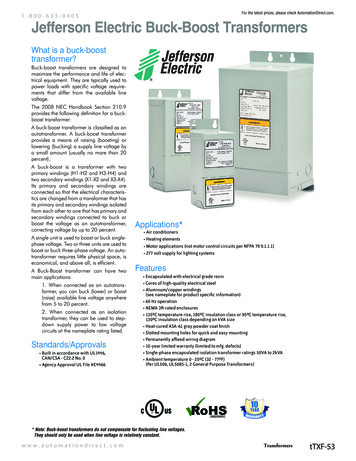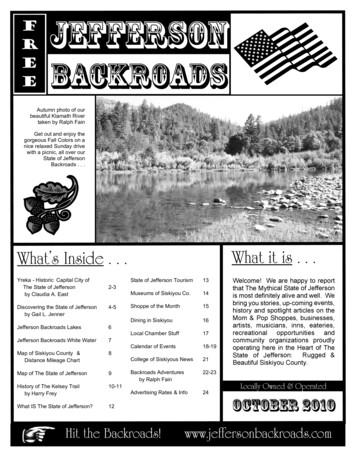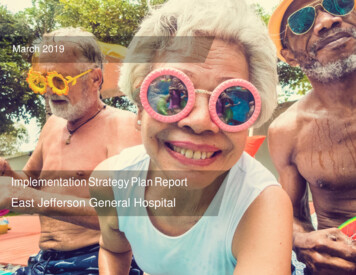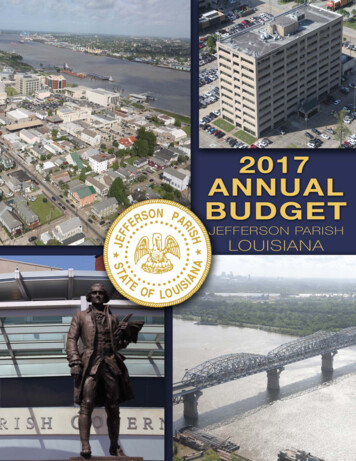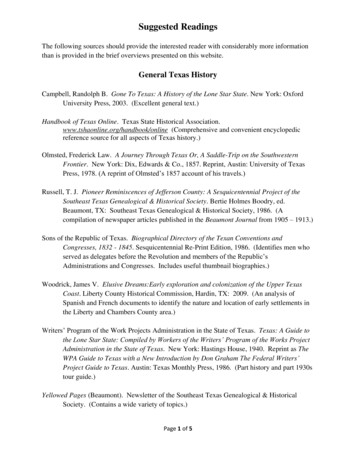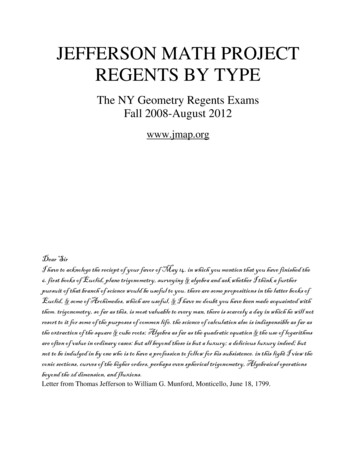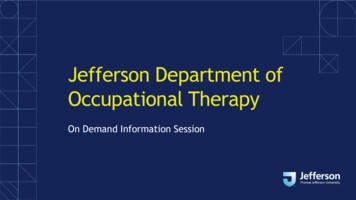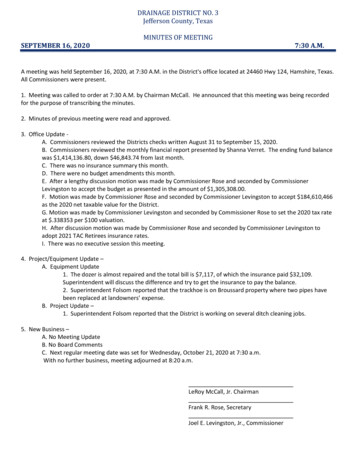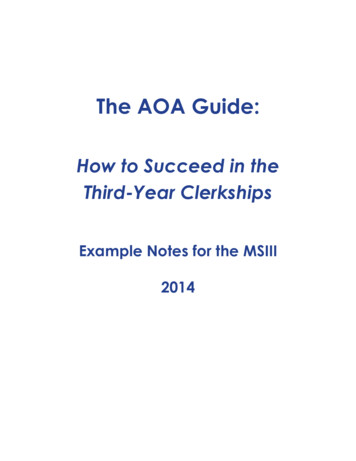
Transcription
The AOA Guide:How to Succeed in theThird-Year ClerkshipsExample Notes for the MSIII2014
PrefaceThis guide was created as a way of assisting you as you start your clinical training.For the rest of your professional life you will write various notes, and althoughthey eventually become second nature to you, it is often challenging at first tofigure out what information is pertinent to a particular specialty/rotation. This bookis designed to help you through that process.In this book you will find samples of SOAP notes for each specialty and a completeHistory and Physical. Each of these notes represents very typical patients you willsee on the rotation. Look at the way the notes are phrased and the information theycontain. We have included an abbreviations page at the end of this book so that youcan refer to it for the short-forms with which you are not yet familiar. Pretty soonyou will be using these abbreviations without a problem! These notes can be usedas a template from which you can adjust the information to apply to your patient. Itis important to remember that these notes are not all inclusive, of course, and otherphysicians will give suggestions that you should heed. If you are having trouble,remember there is usually a fourth year medical student on the rotation somewhere,too. We are always willing to help!Table of ContentsInternal Medicine Progress Note (SOAP).3Neurology Progress Note (SOAP). 5Surgery. 7Progress Note (SOAP). 7Pre-Operative Note. 8Operative Note.8Post-Operative Orders. 8Post-Operative Note. 9Obstetrics and Gynecology.10L&D H&P. 10Delivery Note. 10Post-Partum Note (SOAP). 10C-Section Operative Note. 11Post-Cesarean Section Note (SOAP). 11Pre-Operative, Operative, and Post Operative Notes for Gynecology (usethe Surgery template for these).11Psychiatry Progress Note (SOAP). 12Pediatrics. 14Outpatient Progress Note (SOAP). 14Inpatient Progress Note (use the Internal Medicine SOAP). 14History and Physical. 15Internal Medicine (complete H&P). 15Adaptations for all other rotations. 20Abbreviations used in this guide.222
Internal MedicineProgress Note7/15/12 (Date) 0630 (Time) MS III Green 3 Progress Note*Note: for Internal Medicine at TJUH, write on the front side of the progress noteprinted off every morning. Your intern will write on the back.S: Pt resting comfortably this morning. Overnight, pt c/o insomnia. Also c/o continued leg pain. Pt rates pain at 5/10. Pt received PRN Percocet x2 overnight. DeniesCP/SOB/N/V/D/F/C. Tolerating PO well, had 2BM overnight.Anything subjective goes in this section, i.e. any pt complaints or problems.O: VS: Tc: 97.4 Tmax: 98.6 P: 80 BP: 120-130/70-90 RR: 20 SpO2: 99% on RA I24 hrs: 3800 mLO 24hrs: 1500 mLBalance: 1800(The below exams are mandatory on every patient, but there will also be examsspecific to your patient to do every day based on their diagnoses, i.e. a neuro examif the patient had a stroke. Put that in this section, as well.)HEENT: PERRL, EOMI, no LADCV: RRR, S1 S2, Ø m/r/gLungs: CTAB Ø w/r/r/cAbd: BS, soft, NT/ND, no rebound, no guarding, no hepatosplenomegaly, nomassesExt: no c/c/eLabs/Studies: (Put a P with a circle around it to indicate pending labs; fill them inlater when the results are available. Write all daily labs and trends in here (ex: Hgb9.2 10.3:CT abdomen 7/14: shows splenic remnants consistent with splenic auto-infarction.A/PThis has many formats, the main two are:1. Problem based (as below)2. Systems based (i.e. list ID, then under that heading have all current infections, their status and the treatment; second list CV, list all problems such asHTN or CAD that relate to that system, their status and the treatment, and so onfor all systems)Ask your attending which of the above systems they prefer, and follow that model.The first sentence is critical as it is usually the first sentence in your presentation.3
The patient is a 28-year-old female with PMH of sickle cell disease, DM II, HTN,GERD, and anxiety who presents with left leg pain and increased reticulocytecount concerning for sickle cell crisis.1. Sickle Crisis Hemoglobin, reticulocyte count stable Pain currently controlled on Dilaudid PCA and PO oxycontin T/C switching to IV morphine today2. DM Controlled on metformin Creatinine levels WNL, cont. metformin Continue SSI (sliding scale insulin)3. HTN Controlled, continue on current meds4. GERD Controlled, continue on current meds5. Anxiety Controlled during the day, but patient continues with insomnia T/C adding Ambien PRN6. FEN (Food, electrolytes, nutrition) Now with good PO intake, can decrease IV fluids to 100 mL/hr T/C Diabetic diet given PMH7. DVT Prophylaxis SCDs (sequential compression devices)8. Disposition Full code D/W (discuss with) team possible D/C (discharge) this weekSignatureLast Name MSIIIA note: The addition of T/C (to consider) and the words “discuss with team” aregreat to use in front of what you want to do. You can also add question marks afterthings if you are unsure. People want to see what you are thinking, but also wantothers to know when they read this that these things are not definite yet (The MSIIIat the top should do that, but people don’t always read that.4Extra Hints Put what day of the antibiotic it is today. So if it is the 4th day in a total of 14days then put “Day 4/14” Writing out medication names and doses is tedious, but sometimes very helpful toget you to remember what medication your patient is on and what dosing regimensare for the medication. Make a copy of your note in the morning after you write it. That way if someone asks you something you don’t remember (the vitals, the sodium today, etc.)you can just pull it out of your pocket and look at it. Depending on the service, youmay wait until after rounds to place the note in the chart.
NeurologyS: No acute events O/N (overnight). Pt. cont. to c/o (complain of) weakness inLLE, now improving.O: VS: T: 37.1 P: 82 BP: 124/84 R: 22PE:Gen: NAD, resting comfortably in bedHEENT: atraumatic, normocephalic; TM clear with visible landmarks; sclera andconjunctiva clear; no LAD, no neck masses or asymmetry, no carotid bruitCV: RRR, normal S1 and S2, no S3, S4, murmurs, rubs, or gallopsLungs: CTAB, no wheezes, rales, or rhonchiAbd: soft, NT/ND, BSx4 quadrants, no masses palpable, no organomegalySkin: no rashes, lesions, petechiaeExt: 2 pedal pulses bilaterally, no c/c/eNeuro: (normal exam)1.) Mental statusAAOx3 (or lethargic/obtunded/etc)N/R/C intactWORLD ß à DLROWRecall 3/32.) CNPERRL, EOMI, V1-V3 intact, FS,palate elevates symmetric, TM,SCM 5/53.) MotorNl B T5/5 strength x4No fix, no drift4.) SensationIntact to LT/PP/Temp/Vib/PropNo agraph, no astereo5.) CoordinationFTN, RAM, and HTS intactAwake, Alert, Oriented to person, place,timeNaming, repetition, comprehension intactSpells world backwardsRecall 3 named objects (red, ball, pen) after2 minutesPupils equal, round, and reactive to lightExtraocular muscles intactSensation in V1-V3 intactFace symmetricPalate elevates symmetricTongue midline5/5 strength in sternocleidomastoidNormal bulk and tone5/5 strength in all 4 extremitiesNo fix or driftIntact to light touch, pin prick, temperature,vibration and proprioceptionNo astereoagnosiaNo agraphesthesiaFinger-to-nose, rapid alternatingmovements, heal-to-shin intact6.) GaitNarrow based, no ataxia, intact totandem and heal-toe, negativeRhomberg5
7.) Reflex: Grade 4 (clonus), 3 (hyperactive), 2(nL), 1(Hypo), 0(none)Arrow at feet: Babinski upgoing ( ) or downgoing (-,nl)Biceps C5Triceps C7Brachioradialis C6Patellar L4Achilles S1Babinski (up/down)A: 64 year old male with PMH atrial fibrillation presents with L-sided weaknessand found to have R MCA ischemic stroke on CT. L-sided weakness continues toimprove, with patient exhibiting increased strength. Patient maintained on warfarin with INRs now in therapeutic range.P:1. Neuro: Continue PT/OT for L sided weakness2. CV: Cont. warfarin at current dose with daily INR3. FEN/GI: Cardiac diet4.Prophylaxis: SCDs (sequential compression devices), OOB with assistance astolerated5. Dispo: pending INR in therapeutic range and homecare6
Progress Note6/5/11 (Date) 0500 (Time)Progress Note MSIII SurgerySurgeryS: 33 yo female admitted for appendicitis, hospital day #3, POD (post-op day) #2,s/p appendectomy. Abx – Flagyl day #1. Patient having some peri-incisional pain,however pain is well controlled with PCA (patient controlled analgesia pump).No drainage from incision site, ( ) ambulation, ( ) BM and flatus. Currently onclear liquid diet and is tolerating it well. Foley still in place. (-) N/V, (-) SOB, noovernight issues.O: VS: Tmax 38.3, Tc 38.1, BP 120/80, P 75, RR 16, O2 99% on RAI/O: 1250/ 2000 x 24hrs, 1000/1200 since midnight, UO (Urine Output) 1100 ccin 24 hours, 46cc/hr, JP (Jackson-pratt drain) - 200cc in 12 hrs, 16 cc/hr, (if patienthad NG (nasogastric) tube, or other drains you would record their 12hr output herealso)Gen: NAD, AAOx3CV: RRR, ( ) S1/S2, (-) m/r/gLungs: CTAB (-) w/r/r/cAbd: ( ) tenderness on palpation in RLQ (right lower quadrant), ND, ( ) BS Incision: C/D/I (clean, dry, intact), (-) erythema, staples intact, JP drain in place Ext:(-) C/C/E, 2 dorsalis pedis bilaterally, (-) calf tenderness, calf SCDs (sequen- tialcompression devices) in place.Labs: CBC, BMP, UA, etc.Imaging: CXR negative, etcA/P: 33 yo female, POD # 2, s/p appendectomy. Patient doing well.1. Low grade fever– probably secondary to atelectasis Continue incentive spirometry Continue Flagyl antibiotics T/C blood cultures if continued fever Encourage ambulation2. Pain is improving T/C switching PCA to oral analgesic3. Diet – tolerating clear liquids Advance to house diet4. Good urine output D/C Foley5. Prophylaxis Continue incentive spirometry Continue SCDs6. Dispo: Pending PO pain mgmt. and inc oral intake7
Pre-Operative Note: (Written the day before surgery)6/1/11 14:00 Pre-op note MSIII green surgeryPreop dx: appendicitisLabs: CBC, BMP, PT/PTT resultsCXR: clearECG: normal sinus rhythm, within normal limitsBlood: Typed and crossed x 2 unitsAnesthesia: preop completed consent for anesthesia is signed and in the chartConsent: signed and in the chartOrders: 1gm cefoxitin OCTOR (on call to OR), NPO (nothing by mouth) aftermidnightOperative Note6/2/11 11:00 OP note MSIII green surgeryOP Note: Green surgery teamPreop dx: appendicitis Postop dx: appendicitis Procedure: Open AppendectomySurgeons: Write attendings, residents, med student present for the surgeryAnesthesia: GeneralFluids: 1200 LR (lactated ringers) Urine output: 500 ccEBL (Estimated blood loss): 50 ccOp findings: no perforationSpecimen: Appendix sent to pathologyDrain: JP drainComplications: nonePost Operative Orders: ADC VANDALISM6/2/11 Post OP orders MSIII green surgeryAdmit: 3 westDiagnosis: appendicitis s/p appendectomyCondition: stableVitals: q (every) shiftAllergies: NKDA (no known drug allergies)Nursing orders: strict I/Os, SCD (sequential compression devices), foley catheter togravity, incentive spirometryDiet: NPOActivity: as toleratedLabs: CBC, BMP in AMIV fluids: D5 ½ NS (normal saline) 20 KCL at rate of 100cc/hrStudies: CXRMeds: Abx: cefotaxime 1 g IV q 8hrs for 24 hoursProphylaxis: heparin 5000 units SCAnalgesic: PCA (patient controlled analgesic) pumpAny preop medications the patient has been on and PRN medsCall house office if HR 100 or 60, BP 180/100 or 90/60 temp 39.58
Post Operative Note (at least 6 hours after surgery)6/2/11 1800 post OP note Green Surgery MSIIIStatus: s/p appendectomy, patient having mild discomfortNeuro: AAOx3VS: stable/afebrileI/O: 1000ml LR (lactated ringers) UO (urine output): 500cc x 6hours Labs: CBC,BMP in amPhysical Exam:CV: RRR, ( ) S1/S2, (-) m/r/gLungs: CTA B/LAbd: Soft RLQ (right lower quadrant) tenderness, (-) bowel sounds, dressing C/D/I(clean, dry, intact)A/P: 33 yo female s/p appendectomy POD (post-op day) # 0 in stable condition1. IV hydration2. Pain management with PCA3. 1 g cefotaxime IV q 8 hrs for 24 hours4. DVT (Deep vein thrombosis) prophylaxis: SCDs (sequential compressiondevices), heparin 5000 units sc9
Obstetrics and GynecologyL&D History & Physical:CC: (vaginal blee
We have included an abbreviations page at the end of this book so that you can refer to it for the short-forms with which you are not yet familiar. Pretty soon you will be using these abbreviations without a problem! These notes can be used as a template from which you can adjust the information to apply to your patient. It is important to remember that these notes are not all inclusive, of .
